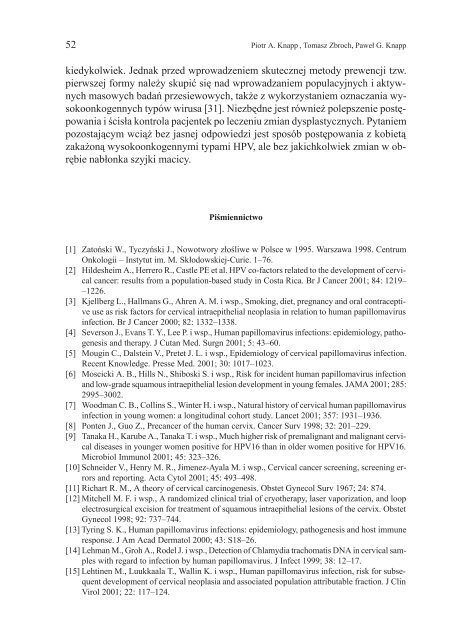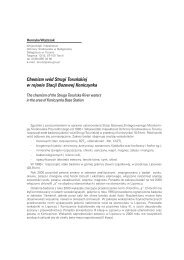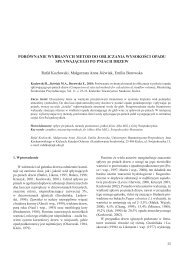Bez tytu u-1 - UJK
Bez tytu u-1 - UJK
Bez tytu u-1 - UJK
Create successful ePaper yourself
Turn your PDF publications into a flip-book with our unique Google optimized e-Paper software.
52 Piotr A. Knapp , Tomasz Zbroch, Pawe³ G. Knapp<br />
kiedykolwiek. Jednak przed wprowadzeniem skutecznej metody prewencji tzw.<br />
pierwszej formy nale¿y skupiæ siê nad wprowadzaniem populacyjnych i aktywnych<br />
masowych badañ przesiewowych, tak¿e z wykorzystaniem oznaczania wysokoonkogennych<br />
typów wirusa [31]. Niezbêdne jest równie¿ polepszenie postêpowania<br />
i œcis³a kontrola pacjentek po leczeniu zmian dysplastycznych. Pytaniem<br />
pozostaj¹cym wci¹¿ bez jasnej odpowiedzi jest sposób postêpowania z kobiet¹<br />
zaka¿on¹ wysokoonkogennymi typami HPV, ale bez jakichkolwiek zmian w obrêbie<br />
nab³onka szyjki macicy.<br />
Piœmiennictwo<br />
[1] Zatoñski W., Tyczyñski J., Nowotwory z³oœliwe w Polsce w 1995. Warszawa 1998. Centrum<br />
Onkologii – Ins<strong>tytu</strong>t im. M. Sk³odowskiej-Curie. 1–76.<br />
[2] Hildesheim A., Herrero R., Castle PE et al. HPV co-factors related to the development of cervical<br />
cancer: results from a population-based study in Costa Rica. Br J Cancer 2001; 84: 1219–<br />
–1226.<br />
[3] Kjellberg L., Hallmans G., Ahren A. M. i wsp., Smoking, diet, pregnancy and oral contraceptive<br />
use as risk factors for cervical intraepithelial neoplasia in relation to human papillomavirus<br />
infection. Br J Cancer 2000; 82: 1332–1338.<br />
[4] Severson J., Evans T. Y., Lee P. i wsp., Human papillomavirus infections: epidemiology, pathogenesis<br />
and therapy. J Cutan Med. Surgn 2001; 5: 43–60.<br />
[5] Mougin C., Dalstein V., Pretet J. L. i wsp., Epidemiology of cervical papillomavirus infection.<br />
Recent Knowledge. Presse Med. 2001; 30: 1017–1023.<br />
[6] Moscicki A. B., Hills N., Shiboski S. i wsp., Risk for incident human papillomavirus infection<br />
and low-grade squamous intraepithelial lesion development in young females. JAMA 2001; 285:<br />
2995–3002.<br />
[7] Woodman C. B., Collins S., Winter H. i wsp., Natural history of cervical human papillomavirus<br />
infection in young women: a longitudinal cohort study. Lancet 2001; 357: 1931–1936.<br />
[8] Ponten J., Guo Z., Precancer of the human cervix. Cancer Surv 1998; 32: 201–229.<br />
[9] Tanaka H., Karube A., Tanaka T. i wsp., Much higher risk of premalignant and malignant cervical<br />
diseases in younger women positive for HPV16 than in older women positive for HPV16.<br />
Microbiol Immunol 2001; 45: 323–326.<br />
[10] Schneider V., Henry M. R., Jimenez-Ayala M. i wsp., Cervical cancer screening, screening errors<br />
and reporting. Acta Cytol 2001; 45: 493–498.<br />
[11] Richart R. M., A theory of cervical carcinogenesis. Obstet Gynecol Surv 1967; 24: 874.<br />
[12] Mitchell M. F. i wsp., A randomized clinical trial of cryotherapy, laser vaporization, and loop<br />
electrosurgical excision for treatment of squamous intraepithelial lesions of the cervix. Obstet<br />
Gynecol 1998; 92: 737–744.<br />
[13] Tyring S. K., Human papillomavirus infections: epidemiology, pathogenesis and host immune<br />
response. J Am Acad Dermatol 2000; 43: S18–26.<br />
[14] Lehman M., Groh A., Rodel J. i wsp., Detection of Chlamydia trachomatis DNA in cervical samples<br />
with regard to infection by human papillomavirus. J Infect 1999; 38: 12–17.<br />
[15] Lehtinen M., Luukkaala T., Wallin K. i wsp., Human papillomavirus infection, risk for subsequent<br />
development of cervical neoplasia and associated population attributable fraction. J Clin<br />
Virol 2001; 22: 117–124.












